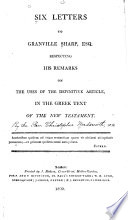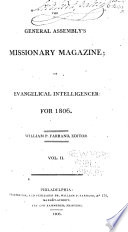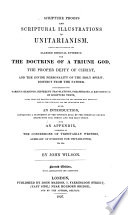 | Christopher Wordsworth - 1802 - 394 pages
...the second noun or participle, the latter *' always relates to the same person that is expressed lt or described by the first noun or participle : ie " it denotes a further description of the first named, " person." — And this rule, with such subsequent qualifications as the stress of the... | |
 | 1806 - 650 pages
...nouns, or participles, and is not repeated before the second noun or participle, the latter always relates to the same person, that is expressed or described...by the first noun or participle ; ie it denotes a farther description of the first-named person: as, EuA«yifl«5 'O ©(•« KAI n«h{ T* Ktiji», &c.... | |
 | Lant Carpenter - 1817 - 624 pages
...participles, and is not repeated before the " second noun or participle, the latter always relates te " the same person that is expressed or described by the " first noun or participle." It is admitted on all hands that this is a common usage of the Greek language ; the only point is,... | |
 | Lant Carpenter - 1823 - 462 pages
...nouns or participles, and ' is not repeated before the second noun or participle, ' the latter always relates to the same, person that is ' expressed or described by the first noun or participle." It is admitted on all hands that this is a common usage of the Greek language; the only point is, whether... | |
 | John Wilson - 1837 - 320 pages
...said nouns or participles, and is not repeated before the second noun or participle, the latter always relates to the same person that is expressed or described by the first noun or participle. — Granville Sharp's Canon. Eph. v. 5.— If this text had no relation to any disputed point, and... | |
 | Aeschylus - 1839 - 442 pages
...the second, the second (and every succeeding attributive, if there be more than two) relates always to the same person that is expressed or described by the first : that is, it denotes a further description of the first-named person. An example of this construction... | |
 | Georg Benedikt Winer - 1870 - 908 pages
...before U.« second noun or participle, the latter always relates to the .same person that a expre>3«d or described by the first noun or participle ; ie it denotes a further doerifCioB of the first-named person." Remarkt on the uses of the definitive ertieU w Ou Oretk text... | |
 | Alexander Buttmann - 1873 - 512 pages
...case, if the Art. precedes the first noun and is not repeated before the second, the latter always relates to the same person that is expressed or described by the first.' It was applied by him (in "Remarks on the Uses of the Definitive Art. in the Gr. Text of the NT"3d... | |
 | Samuel Cox, Sir William Robertson Nicoll, James Moffatt - 1921 - 506 pages
...said nouns or participles, and is not repeated before the second noun or participle, the latter always relates to the same person that is expressed or described...by the first noun or participle : ie, it denotes a farther description of the first-named person." Now, it is not easy to lay down a universal principle... | |
 | A. T. Robertson - 1923 - 152 pages
...said nouns or participles and is not repeated before the second noun or participle, the latter always relates to the same person that is expressed or described...by the first noun or participle: ie, it denotes a farther description of the first named person." Now it is not easy to lay down a universal principle... | |
| |